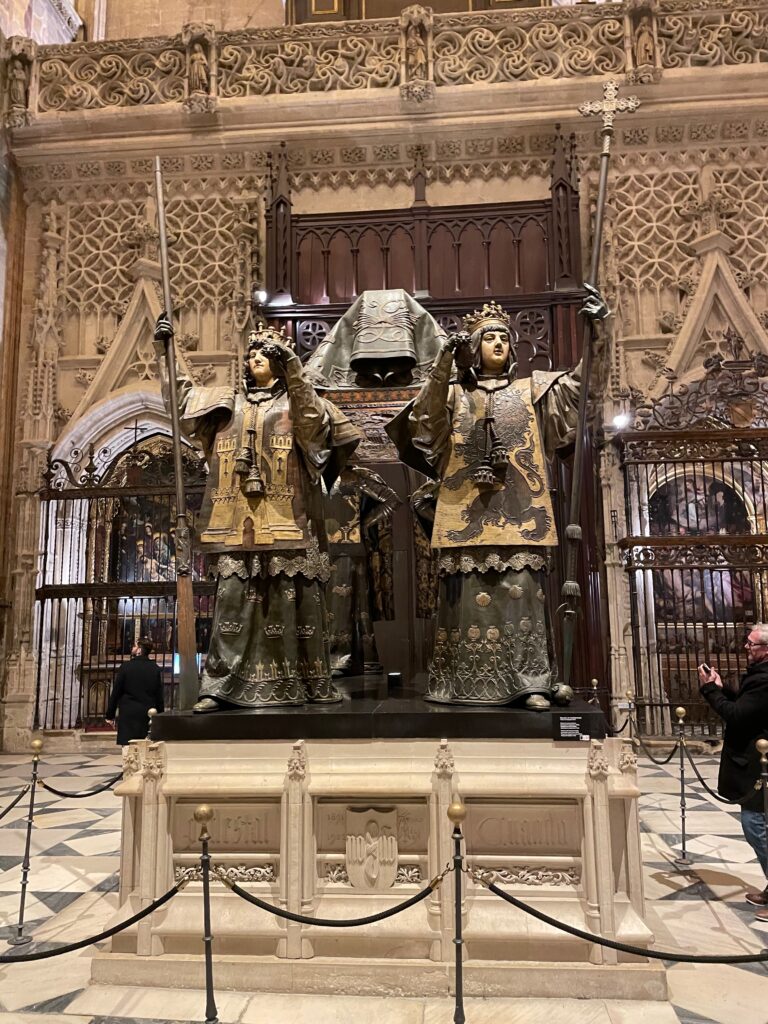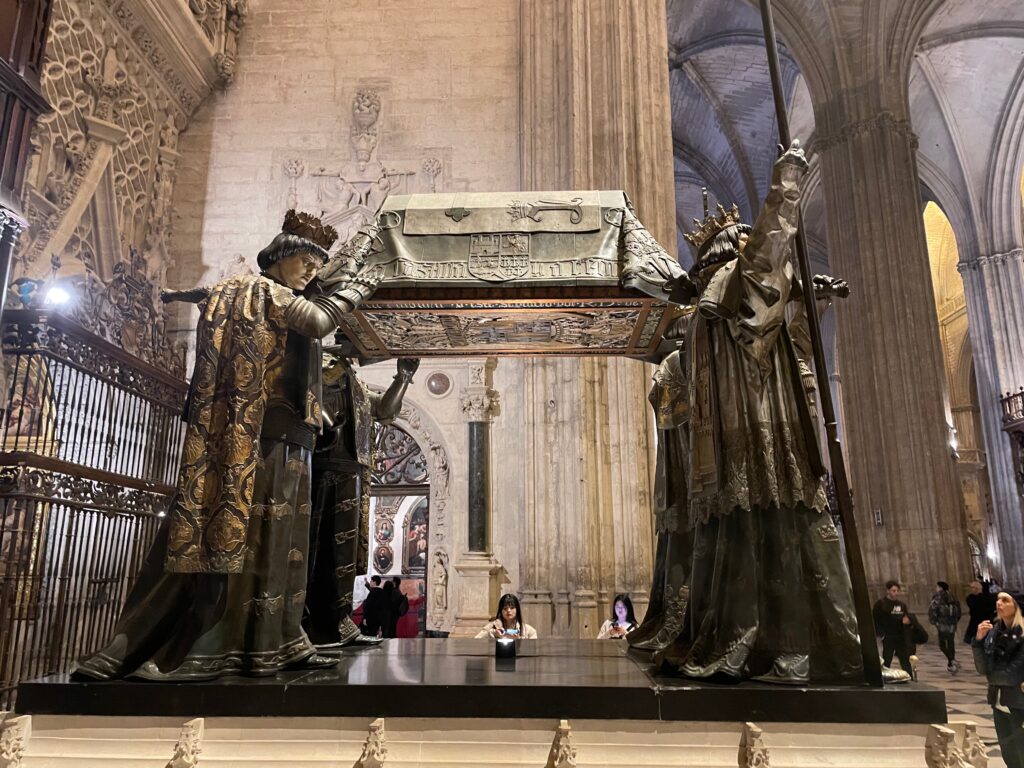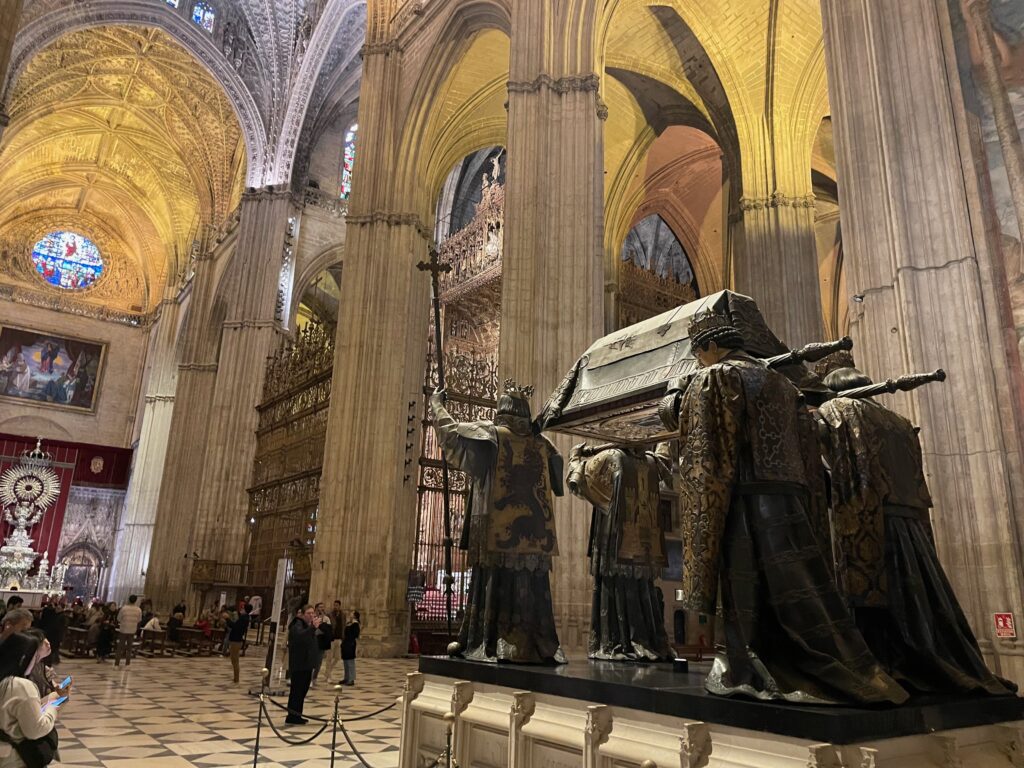Erik Visits a Non American Grave, Part 1,786
This is the grave of Christopher Columbus.




Hoo boy……
I’m largely just going to copy from my Columbus Day labor history post from earlier this year, which lays most of it out. Do we really need a basic bio here? I don’t think so.
Columbus was both a smart guy and an idiot at the same time. In case anyone still thinks this, everyone knew the world was round. The idea that everyone thought the world was flat and Columbus was this genius who thought it was round was complete bullshit made up by Washington Irving in the early 19th century to create his beloved American mythology. The Greeks had more or less figured out the circumference of the Earth a long time ago. Their predictions about the Earth’s size were pretty close to accurate too. It’s just that everyone thought there was nothing out there between Europe and Asia. Columbus wasn’t some genius. He had his own personal calculations of the planet’s size that claimed the Greeks were wrong and the Earth was in fact much smaller. So he convinced the King and Queen of Spain to fund a trip–after all, what did they have to lose? If Columbus died, who cares? Then of course he gets to Hispaniola, sees nothing there that has anything to do with what the Spanish expected due to the goods they got through Muslim middlemen from southeast Asia, and remained determined that this was the Spice Islands by God. Even though everyone else was like, wait a minute, this is something new.
I still remember when I first found out that the Columbus thought the world round thing was a myth, which was my senior year of college when a professor discussed it. I was outraged at being lied to my whole life and I don’t think I’ve ever fully recovered.
Anyway, on the first voyage, Columbus took maybe two dozen Tainos back to Spain. Were they slaves? Well, they weren’t really conceptualized as such. They were examples, evidence. Some may have chosen to go. It was after all a life-changing experience for everyone involved and some may have desired to see what all this was about. But some were captured too. One man volunteered to go when his wife and children were captured. It’s certainly not a good story, but the true horrors were to come.
It’s really the second voyage in 1493 that things get awful. He had left some men in Hispanola. He went back to Spain and by the time he returned on the second voyage, all the men he had left were dead, killed by Tainos after they argued over gold and then stole indigenous women as sex slaves. Finally, a Taino leader named Canoabo led forces to kill the rest of the Spanish. Columbus’ men then captured Canoabo and sent him to Spain. He died on the voyage. Columbus routinely used torture and mutilation in governing Hispanola, with cutting off ears and noses a popular punishment.
By this time, Columbus saw himself as an outright slave trader. This was the future for European wealth. Columbus had seen the new fort in Guinea the Portuguese had constructed that already sold some slaves, though it would be a long time before this became the infamous slave trade. But in February 1495, he sent 550 Taino and other peoples from the islands he explored on a ship back to Spain for that nation’s slave markets. Already, some were being used as sex slaves, a side to slavery we still don’t talk about often enough. We know this from the diaries of some of the officers Columbus had brought along who enslaved young Carib girls for sex. In fact, those 550 slaves were just a fraction of the people Columbus and his men had captured, at least 1,600. The reverse Middle Passage was pretty well as brutal as the more infamous one from Africa to the Americas later. About 200 of the people died on the voyage to Spain.
Columbus proposed to turn Hispanola into the next Guinea, the center of slavery. But Ferdinand and Isbella were not interested in this. In fact, while they had approved the sale of the surviving Natives when they arrived in Spain, four days later, they changed their minds and issued a counter-order. There were theological and spiritual considerations to be made. What were these people? Did they have souls? The Spanish had a long slavery tradition, but generally that was under the idea of enslaving enemies at war. Were these indigenous people enemies? So they created a body of theologians and lawyers to work all this out. They took a full five years to come up with an answering, not until 1500. We also don’t know the answer–the document no longer exists. But we do know Queen Isabella particularly came out against Native slavery. When Columbus sent another group of Indians to Spain as slaves in 1499, she exploded in rage, stating “Who is this Columbus who dares to give out my vassals as slaves?” We also know that in 1500, she gave a bunch of Indians the choice to go back and almost without exception, they did.
Columbus damn near died in Jamaica in 1503 on his fourth voyage, when they crashed there after storm damaged a ship. If some of his men hadn’t rowed a canoe to Hispaniola, he may well have. The reason Columbus was able to survive is that he knew that there was a likelihood of an eclipse in 1504 and when it happened, it convinced the Tribes to keep supplying him because of his power, despite his obvious murderous violence. Unfortunately, he was rescued.
Also, Columbus was too high on his own supply to even recognize that where he was wasn’t Asia. It had to be Asia. He did his own research! That’s why the continents are named for Amerigo Vespucci and not Columbus. He was naturally litigious as all hell with the Spanish crown, demanding 10% of everything from the Americas for himself. It might not shock you that Madrid was less than interested in this arrangement. Despite failing health, from gout, from his many voyages. possible from sexually transmitted diseases, he kept pressing his claims on the Spanish crown. Finally, and with no great sadness from said crown, he died in Valladolid in 1506, at the age of 54.
Columbus’ remains have been all over the place. First they were in Valladolid. Then they were moved to Seville in 1513. Then they were sent to Santo Domingo, in what is today the Dominican Republic, in 1536. Then in 1793, they went to Havana. Then in 1898, the Spanish took him with them when they left Cuba after the U.S. took it over. A 2003 DNA sample demonstrated that the remains in the Seville Cathedral, which is where I took this picture, are at least partly of Columbus. There are at least some claims that some of his remains are still in Santo Domingo and in fact, the U.S. had whatever they are on a boat that opened the Panama Canal. Class all the way here.
Also, I was very excited for this grave visit, maybe not the actual highlight of Seville, but kinda a personal one.
If you want this series to visit other violent Europeans who explored what is today the Americas, you can donate to cover the required expenses here. Hernan Cortes is in Mexico City and James Cook is in Kealakekua, Hawaii (leaving behind whether Hawaii is part of the Americas, it is the United States). Previous posts in this series are archived here and here.


